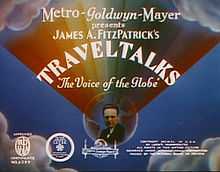James A. FitzPatrick
- For the New York politician, and namesake of the power plant, see James A. FitzPatrick (New York).

James Anthony FitzPatrick (February 26, 1894 – June 12, 1980) was an American producer, director, writer and narrator, known from the early 1930s as "The Voice of the Globe."
Biography
James Anthony Fitzpatrick was born in Shelton, Connecticut. After completing training in dramatic arts, he worked, for a while, as a journalist. In 1916, he entered in films by starting the Juvenile Film Company in Cleveland, producing comedy shorts featuring children and anticipating by years similar series such as Our Gang and The Little Rascals.[1] However, the series was not a success; by 1921, FitzPatrick was working as a writer/director in Charles Urban's American Kineto concern, making a series entitled "Great American Authors" which featured profiles of famous American writers.[2] Kineto folded, however, in 1924, and in 1925 FitzPatrick established his own company and undertook two concurrent series, "Famous Music Masters"—fictionalized shorts about the lives of famous composers—and "Songs of." These were distributed worldwide, and some were later synchronized to sound.[3]
In 1930, FitzPatrick began filming travel documentaries for British and American viewers.[4][5] MGM distributed the series under the umbrella title "Fitzpatrick Traveltalks." From 1934's "Holland in Tulip Time," the TravelTalks were shot in Technicolor, making this series one of the first regular vehicles for color film in the American film industry. After FitzPatrick and MGM parted company in 1954, he went to Paramount, producing a similar "Vistavision Visits" series for about another year before retiring. He died at the age of 86 in Cathedral City, California.
Legacy
FitzPatrick made nearly 300 films in a career that spanned five decades. He was, in some ways, the heir to Charles Urban's approach to making travelogues: they concentrated on the picturesque elements of a nation visited—architecture and landscape—and not, so much, the people. IMDB reproduces an unsourced quote from FitzPatrick which reads,
"How would I have gained admittance to those countries if I had commented on their social problems? [...] I made my pictures at a time when travel was almost impossible for the average person. I believe I showed people what they would have wanted to see if they could have gone themselves. [...] I don't recall anyone ever requesting a tour of slums and prisons."[6]
Fitzpatrick also relates to Charles Urban in his advocacy of color, which he first employed in "Charles Gounod" (1928), a film in the Famous Music Master Series.[3]
With the coming of television, Hollywood began to reduce their reliance on short subjects and many shorts departments began to close; FitzPatrick owned his own unit and managed to survive longer than many internal studio units, but the writing was on the wall by the time he bowed out. FitzPatrick Pictures only produced five features, and three of these intended for release only in the UK; the last one, "Song of Mexico" (1945) was released by Republic Pictures. In the twenty-first century, the Traveltalks are notable for preserving cityscapes before many of them had skyscrapers or international hotel chains, and ways of life that are now defunct, though these are presented in a very general way. The TravelTalks are often shown yet today on Turner Classic Movies as filler material between features.
Selected filmography
- David Livingstone (1936)
- Auld Lang Syne (1937)
- Bells of St. Mary's (1937 film) (1937) starring John Garrick
References
- ↑ Anthony Slide, "Juvenile Film Company" in The New Historical Dictionary of the American Film Industry, The Scarecrow Press, Inc., Lanham, MD and London, 2001.
- ↑ "John Greenleaf Whittier (1921)". IMDb. 23 October 1921. Retrieved 11 April 2015.
- ↑ 3.0 3.1 "NitrateVille.com • View topic - Famous Music Master Series". nitrateville.com. Retrieved 11 April 2015.
- ↑ "James A. Fitzpatrick". BFI. Retrieved 11 April 2015.
- ↑ "James A. FitzPatrick". IMDb. Retrieved 11 April 2015.
- ↑ "James A. FitzPatrick". IMDb. Retrieved 11 April 2015.
External links
|